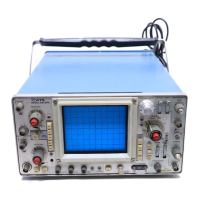TM 11-6625-2735-14-1
Two Megahertz Clock
U330C and U330D form an astable multivibrator having
a repetition rate of two megahertz. The rectangular output
waveform connects to the Switching Logic Flip-Flops
through nand gate U330B. Only in the CHOP position of
the VERT MODE switch is a LO level applied to the input of
inverter U330A. This puts a logical HI in pin 13 of U330D,
which permits the astable multivibrator to free-run. At the
same time, Q338 is biased on, which puts a logical HI on
pin 5 of U330B. Thus, the signal present at pin 6 of U330B
will be the two-megahertz clock signal.
Chop Blanking Amplifier
The Chop Blanking Amplifier Q348 provides an output
pulse to the Z Axis Amplifier circuit, which blanks out the
transitions between the Channel 1 and Channel 2 traces
when operating in the CHOP mode. The inherent
propagation delay of inverters U340A, U340B, and U340C
are used to provide some signal delay to the chop blanking
signal. This allows the blanking signal and the channel
switching transient to arrive in the CRT simultaneously.
Channel 2 Signal Output Amplifier
Q420 and Q430 compose the Channel 2 Vertical Signal
Output Amplifier. A sample of the Channel 2 signal from
pin 5 of Channel Switch IC U370 is amplified and inverted
by Q420. CR422 provides thermal compensation for the
base-emitter junction of Q420. Common-base amplifier
Q430 provides the final amplification and isolates the
output from the internal amplifier circuitry. Output im-
pedance of the amplifier is equal to the parallel combina-
tion of R431 and R432 (approximately 50 ohms).
Normal Trigger Pickoff Amplifier
The trigger signal for NORM trigger operation is
obtained from a sample of the vertical deflection signal
that is available from pin 15 of U370. Normal Trigger DC
Center Adjustment R425 sets the DC level of the normal
trigger output signal so that the sweep is triggered at the
0
level of the displayed signal when the Triggering LEVEL
control is set to 0. Q390 and Q396 are connected as a non-
inverting feedback amplifier. Gain of the stage is ap-
proximately 2.75.
Scale-Factor Switching Circuits
The vertical deflection factor for each channel is
indicated by back-lighting the appropriate figures im-
printed on the flange of each VOLTS/DIV knob. For
purposes of explanation, only the circuit action of the
Channel 1 Scale-Factor Switching circuit is discussed.
With a cable or an X1 probe connected to the CH 1 OR X
input connector, the probe coding ring terminal on the
connector is not contacted, and therefore presents an
open to the base of Q312. This causes Q312 to be biased
off and the X10 display factor bulb to be off. The base level
of Q314 is held low by this action, thus Q314 is biased on
and conducts current to light the X1 display factor bulb.
When an X10 probe with a scale-factor switching
connector is attached to the CH 1 OR X input connector,
the probe coding ring terminal on the connector is
contacted; the base of Q312 is connected through R311,
R310 and an 11,000-ohm resistor (within the probe) to
ground. Now, Q312 conducts through X10 display-factor
bulb DS312. The positive level at the collector of Q312
turns Q314 off, the X10 display factor bulb is on, and the X1
display factor bulb is off.
VERTICAL OUTPUT AMPLIFIER
General
The Vertical Output Amplifier provides the final
amplification for the vertical deflection signal. This circuit
includes the BEAM FINDER function. The BEAM FINDER
pushbutton, when pressed, limits the vertical and horizon-
tal deflection to within the viewing area and sets the trace
intensity to a normal viewing level to aid in locating an off-
screen display. A schematic of the Vertical Output
Amplifier is shown on Diagram 4 at the rear of this manual.
First IC Amplifier
The first amplifier stage in the Vertical Output Amplifier
is integrated circuit U450. U450 is basically an emitter-
coupled, push-pull, cascode amplifier cell. Biasing is
arranged so that there is no phase-inversion through the
stage. The signal from the delay line is applied to the
amplifier through C441, L441, L442, C445, and L444.
These inductances and capacitances are part of the
etched runs of the circuit board and provide some high-
frequency peaking by forming a T-coil circuit without
mutual coupling. Most of the remaining external com-
ponents connected between pins 2 and 3 of U450 provide
high-frequency compensation for the delay line.
Connected between pins 2 and 3 of U450, internally, a
resistor (approximately 33 ohms) has a large effect on the
gain of the stage.
RT452 changes in value with variations in ambient
temperature to compensate for temperature-associated
changes in amplifier gain. The BEAM FINDER pushbut-
ton, when pressed, removes –8 volts from the top of R459.
This reduces the dynamic swing capabilities of the stage
to limit the display on the CRT to within the viewing area.
The gain of the Vertical Output Amplifier section is
adjusted in this stage by adjusting Vertical Output Gain
R449.
3-9

